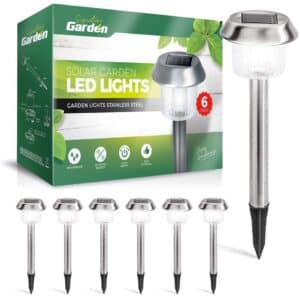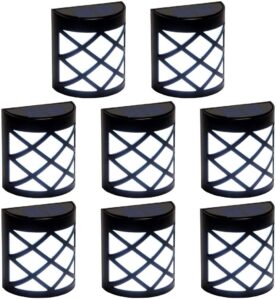
Looking to shed some light on your garden or patio without driving up your electricity bill or running wires across the yard? Solar lights are the answer!
Solar lights are a brilliant way to light up your garden or patio without struggling with wires or adding to your energy bill. But if you live in a place with frequent cloud cover, you may be wondering whether or not this investment is worthwhile. Do solar lights even work when it’s overcast?
Do Solar Lights Charge On Cloudy Days?
In general, some sunshine comes through even on the cloudiest days, and solar panels will still work even when the sky is overcast. Of course, they won’t work as efficiently as they do in sunshine. Depending on how thick the cloud cover is, the panels will produce less than half of their normal output…sometimes as little as 10% of what they can generate on a sunny day.
Your solar lights will still work on cloudy days. The right kind of clouds may even increase the power generated by the solar cells on your light. If the sky is a bright, glaring pearl gray, your solar lights should charge just fine.
When light, fluffy clouds cover the sun, solar cells can absorb the reflected light and may store even more energy than they would be able to on a sunny day.
Here are some types of clouds that won’t impair your solar lights’ ability to charge:
- Cirrus: delicate, feathery clouds high in the sky
- Cirrostratus: thin white clouds that hang overhead like a veil
- Cirrocumulus: patchy, thin, sheet-like clouds
- Cumulus: fluffy white clouds in a blue sky
And here are some types of clouds that may blot out the sunlight and leave you with limited solar power:
- Altostratus: thick gray clouds that cover the whole sky
- Nimbostratus: dark gray clouds that blend with precipitation
- Stratocumulus: patchy gray clouds that often come before a storm
If the cloud cover is dense, the lights won’t be able to generate much power at all. They may still store enough power to light up automatically after sunset but probably won’t shine for as many hours as they would after a sunny summer day.
Be sure to position your solar panels in direct sunlight so that they can make the most of whatever light is available. Solar panels generate very little electricity in the shade.
Do Solar Lights Charge At Night?
Solar lights will not charge at night. Starlight and moonlight aren’t strong enough to power solar panels. Solar lights store daytime sunlight as energy in their battery systems so that they can light up your world at night.
Do Solar Lights Need Direct Sunlight?
Solar lights function best when they get at least some direct sunlight. How much they need to function properly depends on the brand and model.
Solar lights are like plants: some need hours of peak sunlight, while others thrive in the shade.
Here are some of the best brands for cloudy days and indirect sunlight
- LITOM IP67 Waterproof Outdoor Solar Landscape Lights
- YUJENY 30 LED Dual Head Spotlights
- Solpex Solar Path Lights
- Otdair Solar Ground Lights
- BEAU JARDIN Solar Lights
How Much Direct Sunlight Do Most Solar Lights Need?
Most brands will function best and shine longest if they get a minimum of four hours of peak sunlight each day. A full day of exposure may work on a cloudy day if the cloud cover isn’t too heavy. Think bright white skies as opposed to dark rainclouds.
How Do Solar Lights Work?
Solar lights generate their own electricity with their built-in solar panels, store that electricity in batteries, and use it to light up the night.
One advantage to solar lights? You don’t have to run any wiring! There’s no need to constantly change out the batteries, either, or plug them in someplace to charge. They have everything they need built-in.
Just put them in a location with direct sunlight and they’re good to go!
Inside most solar lights, you’ll find a battery, LED, and controller board. Some models include photo registers, which detect light so that the solar lights can turn on automatically when the sun goes down. The solar cells in solar lights are what allow them to capture the energy generated by the sun.
How Do Solar Cells Work?
Solar lights use photovoltaic cells, which are able to convert sunlight directly into electricity. Solar panels are made up of groups of cells connected together and placed in a frame.
The cells themselves are made with special materials known as semiconductors. Silicon is the most common material used for this purpose.
When light hits a cell, some of this energy from the sun is absorbed into the semiconductor. The energy knocks electrons loose from their atoms.
An electric field forces these electrons to flow in a certain direction. This flow of electrons is an electrical current, and this current will flow through metal. In solar lights, a diode prevents this energy from flowing back out of the battery.
What Kind Of Solar Lights Should I Buy?
Start by walking around your property at night to decide which areas you want to illuminate. Pay particular attention to pathways, gates, and doors. Choose the lights that suit your needs and match your decor.
Some solar lights lay flat on the ground. Spikes keep them secure in the turf. These flat lights are a clever way to light paths without anything getting in the way.
Most solar lights are mounted at the top of a stake that stands in the ground. These come in a variety of styles and colors. Some are quite powerful, while others are pleasantly subtle. There are even lights that cast decorative shadows.
Many solar lights are designed to be hung on walls or fences. There are even special solar lights designed to illuminate the steps of your stairs.
There are even bright floodlights that run on their own solar power.
Here are some fan favorites to get you started.
Powerful Solar Lights:
- RaLights 298 LED ULTRA-BRIGHT SOLAR LIGHTS by TBI Pro
- Signature Garden 6 Pack Solar Garden Lights
- Aootek 182 Led Solar Outdoor Motion Sensor Lights
- Agoist Solar Ground Lights
- LITOM 12 LEDs Solar Landscape Spotlights
- URPOWER 2-in-1 Waterproof 4 LED Solar Spotlight
- Ring Solar Pathlights and Ring Solar Steplights
- Balhvit Glass Solar Lights – Super Bright Solar Pathway Lights
All of these are great options but my personal favorite from this bunch is the Signature Garden 6 Pack Solar Garden Lights. This is because they give off a bright 15 lumens of light making them great for garden paths and walkways. They also have an 8 pack for those of you with extra-long walkways. I also tend to prefer lights with the solar panel built into the top of the light rather than one that sticks up off to the side…I always feel like that breaks the aesthetic a bit. Check here for the current Amazon price.
Beautiful Solar Lights:
- Brightech Ambience Pro Waterproof, Solar-powered Outdoor String Lights
- AMIR Upgraded Solar Powered String Lights
- Ciyoyo Solar Deck Lights
- Aityvert Solar Lights Solar Flickering Flame Torch
- GIGALUMI 8 Pack Solar Fence Lights
- Foxdott Solar Path Lights
- YoungPower LED Solar Pathway Lights
- Maggiftt Solar Pathway Lights
- MAGGIFT 6 Pack 25 Lumen Solar Powered Pathway Lights
- Shengsite Deck Solar Lights
Again, you can’t go wrong with any of these options, but under the “beautiful” category my vote goes to the GIGALUMI 8 Pack Solar Fence Lights. I like their simple half cylinder with a crosshatch pattern and they give off enough light to help you see where you’re stepping without absolutely blinding you…a very soft light. They can hang from a fence or attach to patio walls. Check them out here to get the current price.
Summary: Solar Panels On Cloudy Days
Solar panels will still charge on cloudy days, but if the cloud cover is thick, they may not charge all the way. This will decrease the number of hours that the lights will shine after dark. Decorative lights don’t need much power, while powerful floodlights may need more sunshine to charge fully and work properly.


